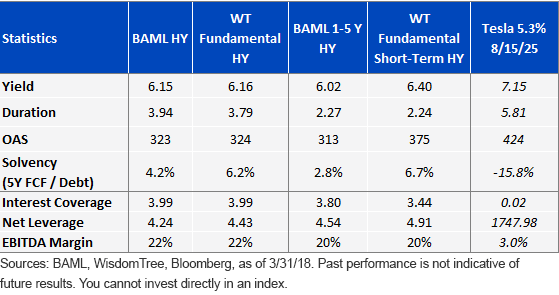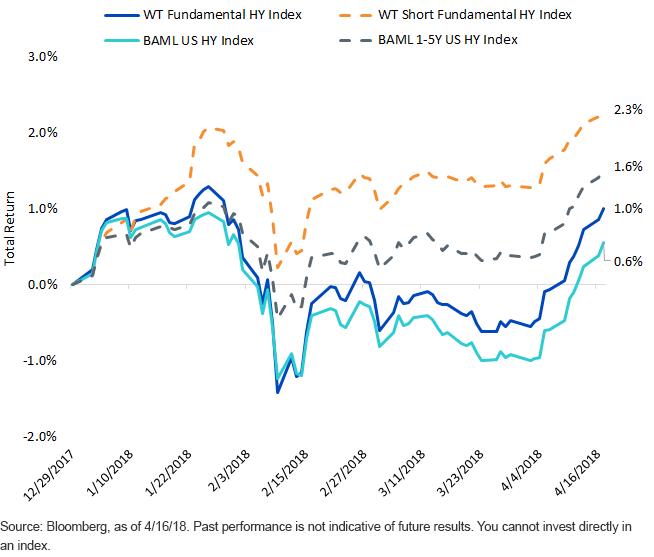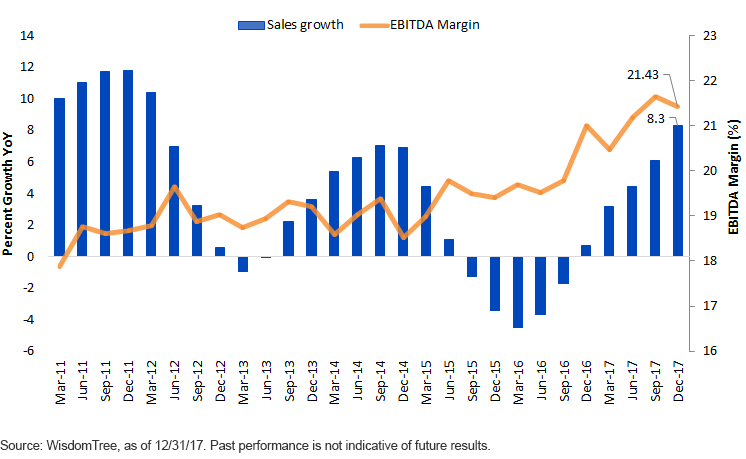What Tesla Can Teach Us About the High-Yield Bond Market



Tesla may be a great company that builds exciting cars, but we wonder if investors are being compensated enough to lend Tesla money. Given its current state of production, Tesla burns mountains of cash and has routinely undershot guidance on delivering cars to eager customers. As a result, free cash flow has been negative since the inception of the business. When companies eventually run out of cash due to persistent negative free cash flow, they have only a limited set of options to avoid distress: sell something (new equity, assets or presale of vehicles) or borrow more money (via loans, term debt, revolvers).
When WisdomTree created our fundamental high-yield (HY) bond Indexes1, we sought to focus on free cash flow as the primary determinant to avoid the pitfalls of market cap weighting. Interestingly, these Indexes avoid Tesla given its persistent negative free cash flows. We examine the characteristics of Tesla’s bonds compared to broad high-yield bond indexes2 and then highlight why, at this stage of the credit cycle, it makes sense to favor a fundamental discipline like the one WisdomTree developed.
Fixed Income Characteristics & Fundamentals

Each of the WisdomTree strategies has a significant premium over market cap for our measure of solvency, five-year free cash flow over debt, and maintains attractive yields. Our short-term strategy is yielding 35 basis points (bps) more than the respective market cap index.
Tesla has a bond maturing in August 2025, with a yield of 7.15% and a duration of 5.81. The yield compensation in Tesla’s bond is not currently pricing too dire an economic situation for Tesla. While Tesla may ultimately turn things around, it will not qualify for inclusion in our fundamental fixed income Indexes unless its free cash flow situation improves markedly. When compared to the broader high-yield bond market, we believe increasing quality at this point in the credit cycle could be prudent.
YTD Cumulative Returns for HY Indexes

Seventh-Inning Stretch in Credit Cycle
To borrow a baseball analogy, we’re not in the late innings of the credit cycle, but we may be nearing the seventh-inning stretch. While many investors fret about the length of the current cycle/market expansion, we continue to remind them that bull markets seldom die of old age. Eventually, economic forces catch up to them. As a result, we believe we may be starting to see a divergence in market returns between the broader market and fundamentally weighted strategies.
In the chart above, we highlight the YTD returns of our short-maturity high-yield Index along with our intermediate-maturity strategy versus market cap-weighted indexes. As you can see, shorter-maturity indexes have outperformed because of higher nominal interest rates. What is also interesting is that we’re starting to see a divergence between the market and fundamentals. The WT Fundamental High Yield Index has outperformed the BAML US High Yield Index by 40 bps, and the WT Short Fundamental HY Index has outperformed the BAML 1-5Y US HY Index by 70 bps. While some may see this warning as a good reason to reduce exposure to high yield, if you sell too early, you may leave a significant amount of returns on the table, particularly as we believe that the underlying trends in the economy and corporate earnings remain robust. Moody’s baseline forecast for 2018’s U.S. HY trailing 12-month default rate is only 2.4%.3 The glue that holds it together is that high-yield corporate borrowers are, for the most part, fundamentally sound.
Growth In Revenue and Profitability for HY Issuers

An important part of the high-yield market’s strong performance in 2017 was in part due to corporate tax cuts and expectations that corporate earnings would improve. In aggregate, HY issues have not disappointed. Throughout 2017, sales growth YoY trended higher, as depicted in the chart above, and HY issuers reported an average 8% YoY sales growth in Q4 2017.4 As earnings growth and profitability have remained robust for most borrowers, credit conditions have generally remained favorable.
However, as we’ve seen in recent months, the market for credit risk can experience periods of volatility just like the equity market. WisdomTree believes that our fundamental approach can provide attractive levels of income while investing in higher-quality businesses.
1The WisdomTree Fundamental U.S. High Yield Corporate Bond Index (WT Fundamental HY) and the WisdomTree Fundamental U.S. Short-term High Yield Corporate Bond Index (WT Fundamental Short-Term HY).
2The ICE BofAML US High Yield Index (BAML HY) and the ICE BofAML 1-5 Year US High Yield Index (BAML 1-5Y HY).
3Source: Moody’s Investor Service, as of 3/31/18.
4Sources: FactSet, Deutsche Bank Research, as of 3/31/18.



